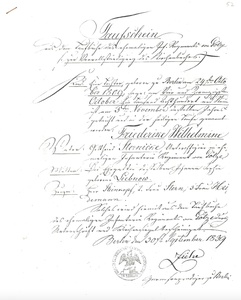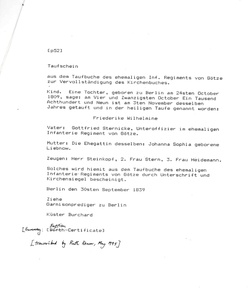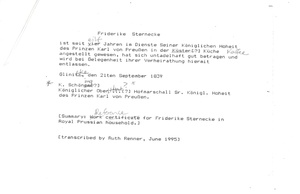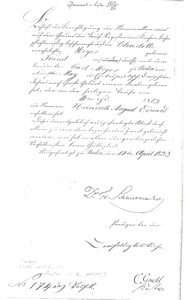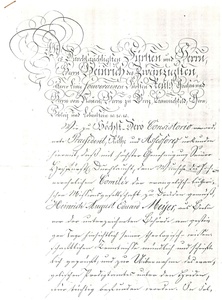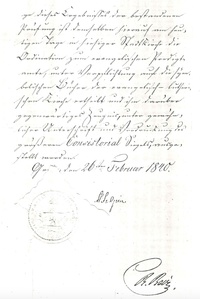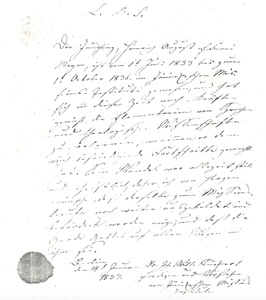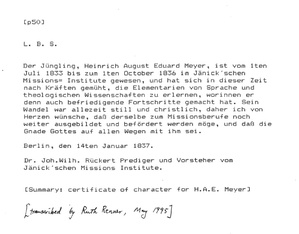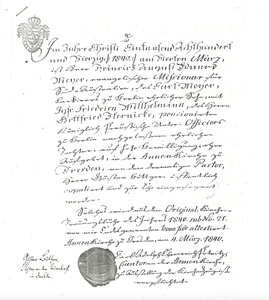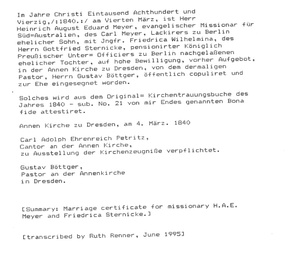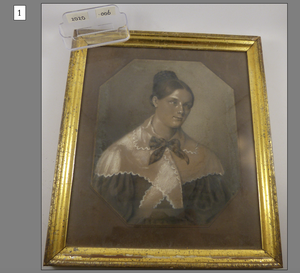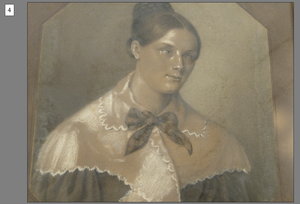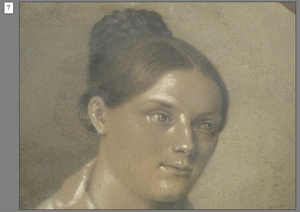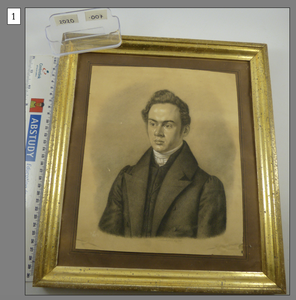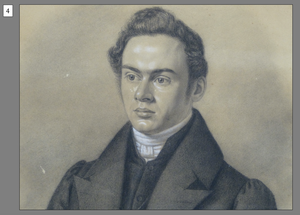This Page forms part of the overall Zebra-ProjectBy clicking on the following Link a list of all Zebra-Project tabbed pages will be displayed. |
|
'Glenn LIEBELT Photographic Collection & Other Archival Material' The LIEBELT / STEINBORN's Johann Gottlieb LIEBELT & Auguste Sophie Louise MEYERher parents were: Heinrich August Eduard MEYER & Friedericke Wilhelmine STERNICKE |
Return to: Steinborn-Liebelt
Summary
A lady in waiting or in charge of the coffee kitchen?
'Under the Southern Cross', by A. BRAUER, 1856 pge 159. Friederike STERNICKE "...had been employed for eleven years in the palace of Prince Charles & Princess Marie of Prussia as custodian of the royal coffers & lady in waiting to the princess, whom she had to assist in her face massage & other 'beauty culture' measures. She was destined to exchange the royal palace for a primitive Australian shack, & the attendance on royalty for the care of uncivilised aboriginals......the marriage of the future missionary & Miss STERNICKE took place on March 4, 1840. A few days later they sailed for Australia."
Griffith University, 'German Missionaries in Australia' by Christine LOCKWOOD. "They set sail from Hamburg on 13 March 1840, travelling via London where they met George Fife Angas who had recruited the DMS missionaries for South Australia with promises of support. They arrived in South Australia on 9 August 1840....... Friederike had been employed for eleven years by Prince Carl of Prussia at his summer palace in Potsdam, where she was in charge of the coffee kitchen."
They travelled on the 'Caleb Angas'.
See 5.3 FAEHRMANN's, LIEBELT'S, First Nations & Prussian Royalty for more information
"Meyer published a grammar of the Ramindjeri Language in 1843." Beyond All Expectations Rob Amery
The family names that are mentioned in this article:
LEIBELT, LOCKWOOD, MEYER, SCHURMANN, STERNICKE, TEICHELMANN
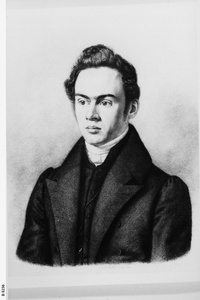 State Library of South Australia, 1836
State Library of South Australia, 1836 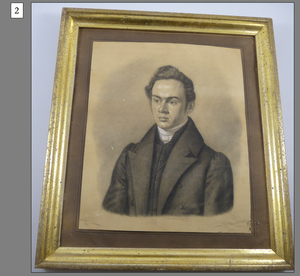 Original from Glen LIEBELT Collection
Original from Glen LIEBELT Collection  Original from Glen LIEBELT COLLECTION
Original from Glen LIEBELT COLLECTION
H.A.E. MEYER [B8236], State Library of South Australia, photograph, 14.3cm x 8.8cm, dated approximately 1836. Artist Jacobssohn S.F. Photo [Out of Copyright/No Known Copyright Restrictions]
- 'Portrait of Heinrich August Eduard MEYER, Lutheran missionary & student of the customs & language of the Ngarrindjeri people.'
-
History/biography, State Library of South Australia.
"The Evangelical-Lutheran Mission Society of Dresden, Germany, was founded in 1819. Although its main work involved sending missionaries to India, in 1838 the society sent two missionaries - Pastor Teichelmann and Pastor Schurmann - to South Australia to work with the Aboriginal people. In 1840 they were joined by Pastors Meyer and Klose. Meyer worked as a missionary to the Aboriginal people at Encounter Bay until 1848 when he was appointed to and served the Bethany community until 1862.
Australian Aboriginal languages became endangered following European contact which began in earnest with white settlement in 1788. It is estimated that at this time there were over 250 different Aboriginal Languages in use. Aboriginal people were forced to speak English in order to receive rations, to go to school, and to have some way of defending their rights.
In contrast to this, much work was done towards the study, recording and translation of Aboriginal languages and customs by these early Lutheran missionaries, including Meyer, who was a gifted language student and produced two publicatons about the language and customs of the Ngarrindjeri people. At the time the main aim of the missionaries in this study was to convert people to Christianity, and now such works are invaluable as a major source for the reclamation of the languages and customs of South Australian Aboriginal nations."
FRONT COVER
These two painted portraits are framed identically to the way the Prussia Palace is framed. They probably belonged to Friederike & Heinrich August MEYER and they now hang in their daughters .....
Aim of Article
Griffith University 'German Missionaries in Australia', by Christine LOCKWOOD.
Theological information. "Because of his ‘need for a wife’s care and assistance’, MEYERE was permitted to marry Friederike Wilhelmine Sternicke on 4 March 1838. Friederike had been employed for eleven years by Prince Carl of Prussia at his summer palace in Potsdam, where she was in charge of the coffee kitchen."
Instructions. "The instructions for Meyer’s wife were that Friederike’s first responsibility was to be to her own household with the special request that she also help care for the domestic needs of her husband’s colleagues. She was not expected to have an active missionary role unless she had the time and inclination to visit and instruct the women.8
Encounter Bay. "Together with missionary Klose, the Meyers set sail from Hamburg on 13 March 1840, travelling via London where they met George Fife Angas who had recruited the DMS missionaries for South Australia with promises of support. They arrived in South Australia on 9 August 1840. Meyer was disappointed to find that Governor Gawler had asked Schürmann to go to Port Lincoln as Deputy-Protector of Aborigines instead of going to Encounter Bay. Eduard and the now heavily pregnant Friederike proceeded alone to Encounter Bay. Teichelmann had concerns about Meyer. He thought he was too weak to work alone, especially as language work required much effort and, he believed, Meyer was not linguistically gifted.9 Meyer was to feel keenly the lack of a colleague, a situation he said would have been unbearable without his wife’s companionship.10
Governor Gawler provided Eduard & his family with a 'crude one-roomed hut' built for the local police near the current position of the Granite Island causeway and it was "dilapidated by 1843" In 1840 there were 150 Europeans & 350 First Nations people around Encounter Bay. He could only survive by growing his own food. Two publications resulted: Vocabulary of the Aborigines of the Southern and Eastern Portions of the Settled Districts of South Australia, 1843, and Manners and Customs of the Aborigines of the Encounter Bay Tribes, South Australia, 1846. On 10 April 1844 the family moved into a "school house / chapel / home for student boarders' cared for by "the MEYERS". "By late 1846 the school had no pupils". Meyer supplemented his income working as a bullocky, carting goods between Encounter Bay and Adelaide.8
Friederike enjoyed teaching the girls to knit, sew and make clothes for themselves and the boys.61 Three evenings a week Meyer taught European children without charge, with Mission Hour and Bible Study on the other weeknights. On Sunday he held services for Europeans (which some Aborigines attended) after which he gathered and addressed Aboriginal adults. He grasped every opportunity ‘to be of use in some way or other to the natives,’ employing them for food and clothing, visiting their huts, caring for the sick, elderly and dying (taking some into his own home), and comforting and interpreting for Ramindjeri prisoners on trial in Adelaide. 62
Beginnings. "The Meyers arrived at Encounter Bay on 13 September 1840. They lived in extreme poverty, often short of food.23 They spent Friederike’s dowry, borrowed money and relied on sympathetic colonists’ donations and gifts in kind to care for sick and needy Aborigines and do other mission work."
The Meyers arrived at Encounter Bay on 13 September 1840. They lived in extreme poverty, often short of food. They spent Friederike’s dowry, borrowed money and relied on sympathetic colonists’ donations and gifts in kind to care for sick and needy Aborigines and do other mission work. Gawler’s promised support fell victim to Governor Grey’s austerity measures in the 1840s’ financial crisis. The hut Gawler supplied was dilapidated by 1843. The location was unsuitable as there were no nearby Aboriginal camps, the soil was too poor for farming and Aboriginal people avoided it as it was too close to the police. Meyer said they hated the police after two Ngarrindjeri men from the Milmenrura lakinyeri of the Coorong were hanged on 23 September 1840 for killing survivors of the shipwrecked Maria in July 1840.
The Meyers had six children, only three surviving to adulthood. Meyer died of stroke on 19 December 1862, aged forty-nine. Some time after his death, Friedericke went to live with her daughter Maria in Hahndorf. Aboriginal people from Encounter Bay visited the two women annually for as long as they lived. Friedericke died in1889 and Maria in 1890. Maria and her husband, Rev. Aldoph Strempel, periodically cared for Encounter Bay Aboriginal children in their home.
Impact of MEYER'S work. "Meyer’s Ramindjeri vocabulary and grammar and Manners and Customs of the Aborigines of Encounter Bay: South Australia have played a significant part in this revival.110 Linguist Mary-Anne Gale, a participant in the Ngarrindjeri reclamation project, calls Meyer a perceptive, persistent and gifted linguist.111 He produced ‘a remarkably insightful grammar’ with many example sentences, and a comprehensive wordlist of 1,670 entries.112 Meyer’s wordlist and grammar formed the basis for that compiled sixteen or seventeen years later by missionary George Taplin.113 Gale says Ngarrindjeri people often prefer Meyer’s work to that of Taplin.114 In 2008 Ngarrindjeri Learners Guide was produced, drawing on Meyer’s and Taplin’s work. Meyer’s example sentences have allowed the construction of new and authentic Ngarrindjeri sentences. Ngarrindjeri is being taught in schools in South Australia, from kindergarten to tertiary level, and used by Aboriginal dance troupes, choirs, bands and groups involved in cultural tourism.115
Gale describes Meyer as humble, compassionate, persistent and hardworking, and a thorough, capable linguist.116 Church historian A. Brauer reports contemporaries describing him as ‘a highly esteemed minister’, ‘a most intelligent and exemplary man’, and ‘extremely kind and able.’117
Table of Content
1. Author's Note. MEYER laboured at Encounter Bay for 8 years, 1840-1848 when he accepted an invitation from the Bethany community which is 2kms S.E. of Tanunda.
Friedericke Wilhelmine STERNICKE 1818-1889 m Heinrich August Eduard MEYER 1813-1862
These photocopies of original documents are not part of the 'Glen LIEBELT Photographic Collection & Other Archival Material' but were scanned by the author at the Lutheran Archives, Adelaide.
Friderike STERNECKE
I st seit eilf Jahren im Dienste Seiner Königlichen Hoheit
des Prinzen Karl von Preußen in der Küster Küche Kaffee
angestellt gewesen, hat sich untadelhaft gut betragen und
wird bei Gelegenheit ihrer Verheiratung hiermit
entlassen.
Glinicke den 21 ten September 1839
K. Schöning
Königlicher Ober. Hofmarschall sr. Königl. Hoheit
des Prinzen Karl von Preußen.
|
|
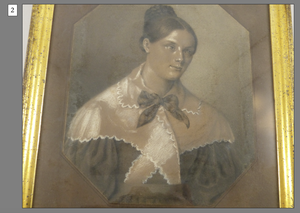 |
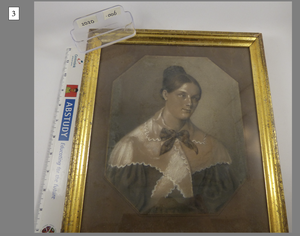 |
|
|
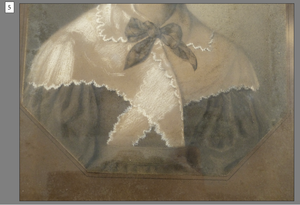 |
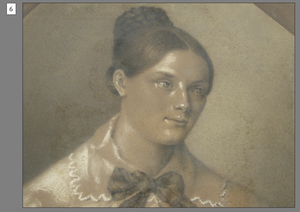 |
|
|
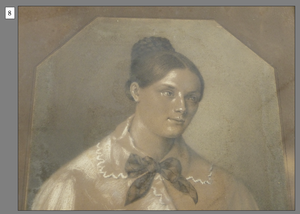 |
 |
|
|
 |
 |
|
|
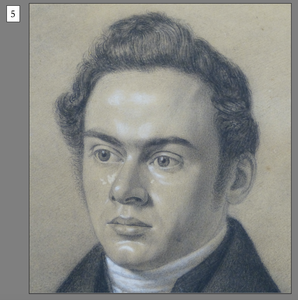 |

